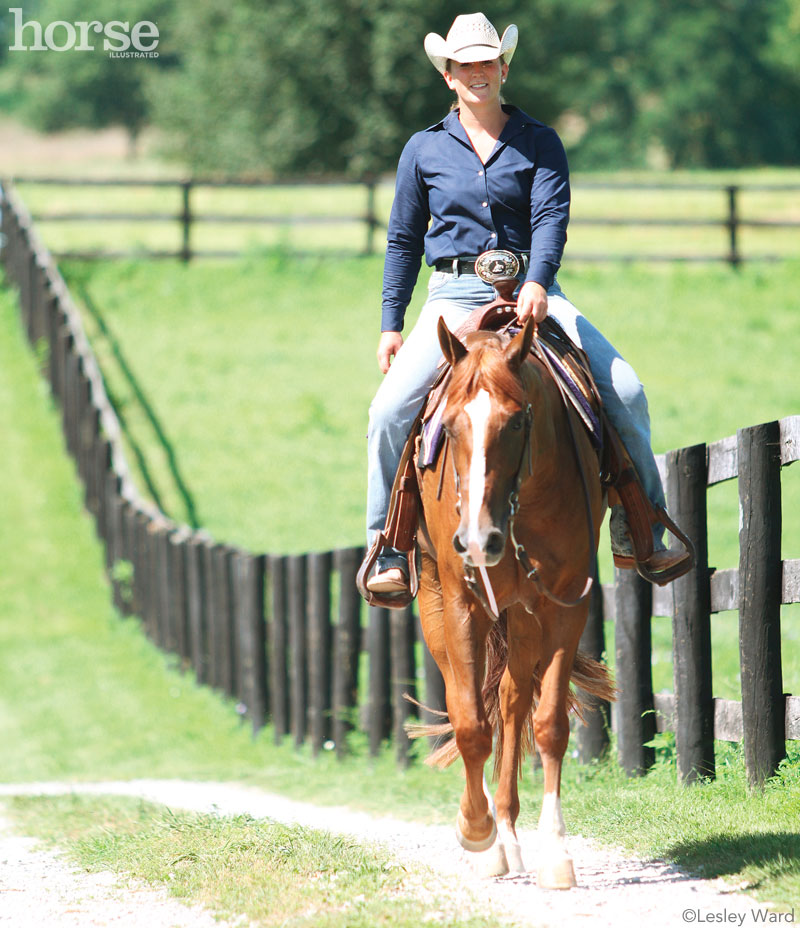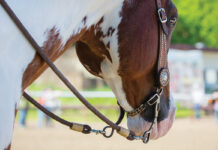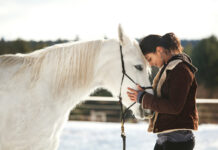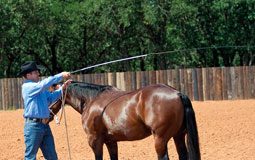Neck reining to a western horse is like a steering wheel is to a car. Without it, you have no control over where you go. It’s one of the first fundamentals a western horse learns, and without good neck-reining responses, a horse won’t do well in western pleasure, reining, barrel racing or most other western events.

Getting Started
For the uninitiated, neck reining is the cue that tells the horse which way to turn. Neck reining uses a loose, indirect rein across the horse’s neck to encourage the horse to move away from the pressure; both reins are loosely held in one hand, which is positioned above the pommel at about waist level.
Explains Bradley, “You give your cue with the pressure of the outside rein against the neck. If you want to go to the right, pick your hand up towards your right shoulder and lay the left rein lightly against the horse’s neck. On a finished horse, the true neck rein is a loose rein: There’s only pressure against the neck and no pressure with the bit at all.”
The neck-rein cue should be very light, and the reining hand should never cross an imaginary line from the horse’s neck to the rider’s shoulder.
Bradley likes to introduce neck reining during a horse’s first mounted lesson. He says that since a green horse must be taught steering anyway, neck reining can be incorporated into that process. “The first day you ride a colt, you can ask them to neck rein,” he says. “They’re not going to respond, but it’s a teaching process and it’s not complicated.”
He usually starts horses in a sidepull for the first few months, then moves up into a D-ring or O-ring snaffle. After about six to 12 months of training, he puts them in a broken-mouth bit, such as a short shank snaffle. Training sessions generally last from 30 to 45 minutes a day, five days a week.
During the first several months of training, Bradley rides with both hands, first asking for the neck rein, then rein-forcing with a direct inside rein. “Too many people forget to neck rein,” Bradley warns. “They just pull the nose to the inside and hope the horse turns. They must use the neck-rein cue, first.”
He begins by having the horse walk forward. “Then when I want to turn slightly to he right, I’ll put the left rein against their neck. Then I shorten the inside rein and actually pull their head to the right. As soon as they respond, I release the pressure.” Initially, turns are not large, only about 10 degrees. After obtaining some sort of turn, Bradley rewards with a release, then repeats the lesson a few more times.
The only other aids Bradley uses when teaching neck reining is to keep his legs in the side of the horse to maintain forward motion and to bump the outside elbow with his stirrup or leg to encourage the horse to move his outside shoulder over. “I want the horse’s whole body to turn, not just his head. If that doesn’t happen, I’ll keep pressure on the reins and use the outside leg to make sure that happens.”
Once the horse neck reins well in a circle at a walk, responding to either just a neck rein or both reins, Bradley starts to neck rein at a trot. Many horses can move up to the trot stage in just two weeks, he says.
When the horse can trot a figure-eight in 30-foot circles well, with either a neck rein or with two hands, Bradley begins neck reining at the lope. But he cautions riders not to attempt neck-reining lessons at faster gaits until the horse responds fairly consistently in a slower gait. “I like them pretty broke to trotting before I try to lope them,” he says. “A lot of people try to lope them the first week, and they don’t have enough steering mechanism. They can get in a lot of trouble.”
If Bradley has difficulties getting a turn at a lope, he drops down to a trot or a walk, but always makes sure he gets some sort of change of direction before releasing the pressure. “If you neck rein and neck rein, and then decide to forget it, the horse will forget it, too,” he warns.
Because neck reining is a simple command, most horses catch on to the basics fairly quickly. “After you ride them about a half dozen times, they’ll start to move away from that pressure,” Bradley says.
Make No Mistakes
Although neck reining is one of the easiest commands to teach a horse, there are still a few ways in which a rider can go wrong. The most common mistake is when the rider wants to turn, but the horse won’t, so the rider pulls one hand farther to the inside. “But the farther your hand goes inside, the more pressure you’re putting on the outside rein, which forces the horse’s head to turn to the outside,” Bradley says. If the horse doesn’t turn, make the correction by going to two hands and shortening the inside rein. “Put their nose slightly to the inside and move the horse’s shoulder over.”
Bradley often sees riders using just one rein to get a turn. “A lot of people, especially when they’re riding youngsters, just pull the rein to the right when they want to turn right. Pretty soon the horse just turns his head to the right, but his shoulder is still off to the left, the hips are swung to the left, and they lose the whole body position. You’ve got to use both reins on the horse to keep his body lined up. The head should be slightly to the right, with the body still going straight. Use more left rein to move the horse’s left shoulder over and to keep his body alignment correct. This is important in all stages, but especially in the first few months.”
Another problem Bradley observes is busy hands. “A lot of people, when they’re just riding along, they’re moving their hands all the time, even the advanced riders in the show.” This constant hand movement sends conflicting signals that could eventually make the horse immune to neck reining cues.
Some riders also make neck reining for the green horse unnecessarily complicated. “I want to keep it very simple so the horse can understand. A neck rein means to turn. I use my legs to keep the motion or as a correction,” says Bradley. The only exception, he notes, is a slight leg cue for the finished horse when performing a spin or a fast lope.
By far the worst mistake a rider can make is inconsistency and not following through. Always insist on getting some sort of turn when you ask, and always reward by releasing. Warns Bradley, “If you continue to pull across their neck and nothing happens, they learn to ignore the pull. Every time the rein touches the side of their neck, you must make them turn slightly, then release the pressure.”
From start to finish, Bradley says that it takes six to eight months to get a horse ready to show in a reining class. “If you’re going to a NRHA reining for 3-year-olds, then they usually require 16 to 18 months of training.” But by heeding Bradley’s advice, neck reining could be one of the easiest commands your horse ever learns.
Further Reading
Steer Clear of Neck Reining Problems






Good article! I wish more people trained horses to neck rein like this. It seems nowadays, at least in Eastern Oklahoma, every horse is trained to direct rein, which is NOT truly western riding! I am looking for a good neck reining horse, and so far it’s been impossible to find one.
I loved this article. I was always taught to work a young horse this way. So I know it works. Just wanted to say thank you for the reinforcement because I just argued with a trainer about this. The trainer said to never start a young horse with neck reigning, to wait till about 3-4 years of age. I just said,”whatever”
I’ve always started neck-reining from the ground then worked my way into the saddle after about three or four 20 minute sessions with the horse and it has always worked for me. Is this wrong?
Very interesting article! I learned alot.
I have a four-year-old gelding and I just recently started riding about a year ago. I don’t know if he’s neck reined or not. I enjoyed the article, but I still need ideas, got any????
i got a 8 year old gilding draft horse and he is not neck rien right i dont have a cule how to do it i go the best way i can but when orher people get on him they confuised him need some help here???????
i honestly think if you want to do neck reighning find a horse that likes it. in my experiances with hundreds of diffrent horses they all have there prefered way of steering and if you do it there way they are more willing to listen and work then if you didnt.
i love neck reining. it is so usefull to have one hand free!
I have had the opportunity to work with Clark Bradley. He did a wonderful job training my gelding. This is an excellent article! I believe people are often trained by their horses instead of the other way around. Horses are smarter than you might think and they will generally take the easy way out if permitted. If you are not qualified to do all of the training yourself then find someone that can help you and your horse. It will be well worth it!
i have 4 year old green b mare my husband and love to go on trail rides but he gets up set with me becoures i will not take dixie greenborke horse) with us on trailrids he thinks all she needs is miles and riding the rainging will come with time.I one the other hand due not think so i just dont think its fair to dixie or either me to have to tray to fight her out there when we due go out with the rest of the horses .. she is a very calm 4 y old but i would love to teach her to neck rain .. so i can take her out .i also have 2 other green borke horses and lol my husband only rides he 12 year old mare that he traind and thinks npw he knows all the horse and how to train them . from your article i have learn a lot and ihope that this spring and summer all 3 will neck rain
My 8yo Paint Barrel mare will neck reing perfectly at a walk or jog. But when i try to make her canter and neck reign at the same time she wont listen i have to plow reign her. exspecialy around the barrels. I hope this helps.
This is a great article! My green horse is just learning to neck rein, and this article was helpful.
Good tips. But what about leg aids? Aren’t they the most essential aids for both western and english riding? The reins are secondary.
good info
I agree with Galadriel, and also, who says a horse has to neck rein to barrel race? I barrel race both of my horses and use direct/plow rein. And I’m pretty sure a horse can keep itself “lined up” in a turn without people having to use two reins all the time. *rolls eyes* How do they survive running and turning in the pasture without us guiding their every move?! *gasp*
If you are doing English style it isn’t neck reining/western riding!
The style of Neck Reining comes from the time of the cowboy when roping a steer. They had to hold the reins to control the horse with one hand while holding and roping the steer with the other..
I love it when a horse is trained to neck rein! It makes riding them a lot easier and more pleasant when you can simply drape the rein on their neck rather than using a direct/plow rein. There’s a reason why its called a plow rein! It’s used for plow horses! Not ones you want to turn on a dime!
I just got a real pleasure horse that is about 12 years old. He responds if the left rein is moves out he turns left if the right, he turns right. Now my nephew is trying to neck reign him and the horse seems confused and at times just stops. Should he be trying to retrain him at this late in the game and will it work? I just enjoy riding him so it is a “right way” vs the way he knows??? Just don’t want to confuse him, he is such a loving easy going ride.
Excellent article! Thanks and GOD BLESS!!!